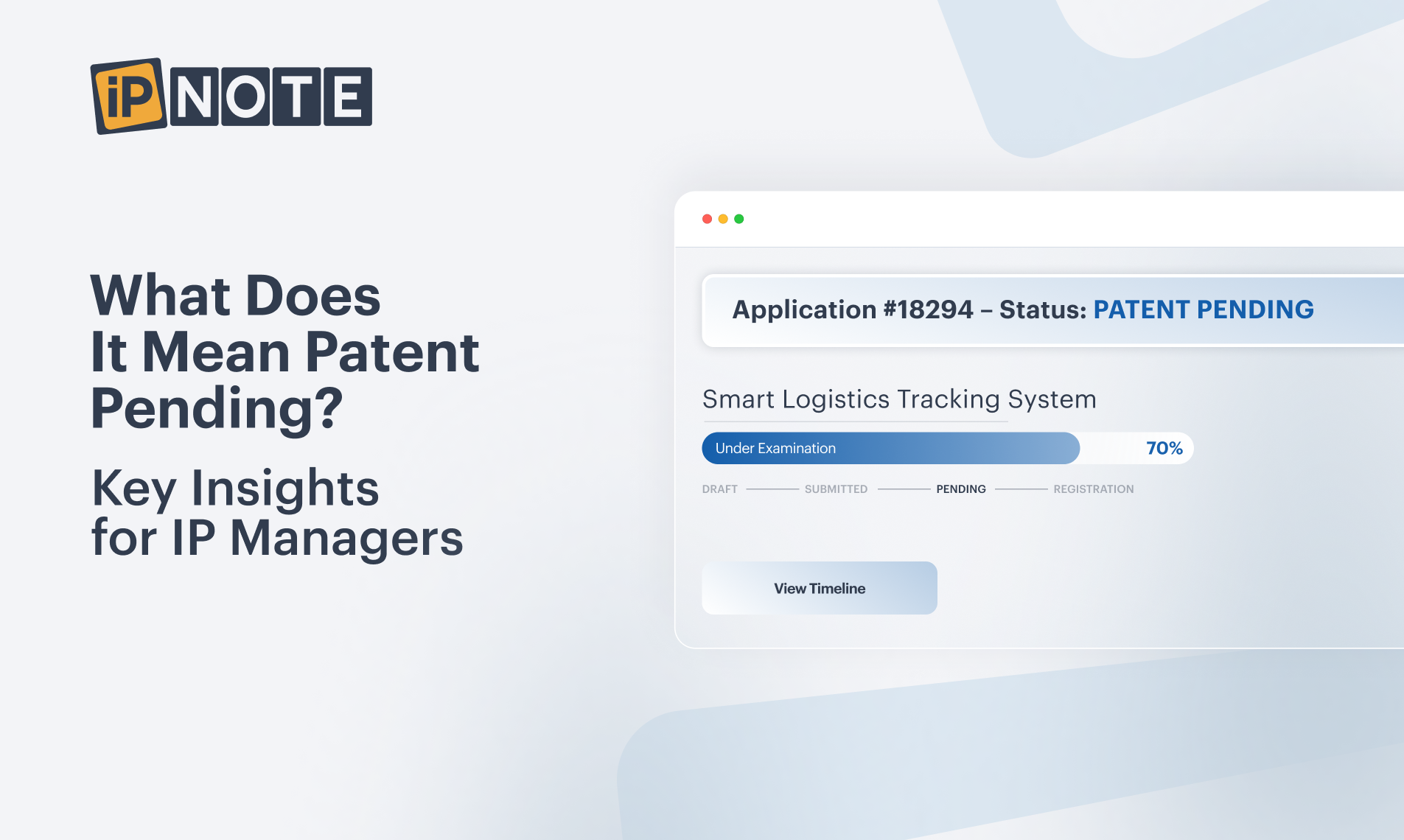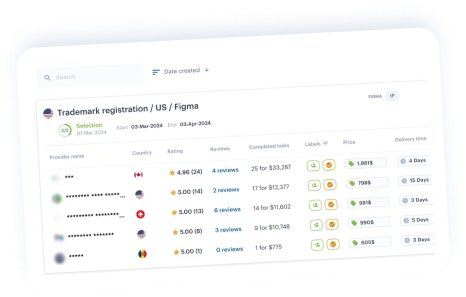Overview
The term ‘patent pending’ denotes the status of an invention for which a patent application has been filed but not yet granted. This indicates that the inventor is actively pursuing legal protection. Such a status serves as a deterrent to potential competitors, while simultaneously allowing inventors to market their innovations. It implies that exclusive rights may soon be granted, thereby enhancing their market position and increasing appeal to investors. Understanding this status is crucial for anyone involved in intellectual property management, as it underscores the importance of protecting innovations effectively.
Introduction
In the intricate world of intellectual property, the phrase ‘patent pending’ carries significant weight, marking a crucial phase in the journey of innovation. This status not only signals to the public that an inventor is actively seeking patent protection, but it also serves as a powerful deterrent against potential competitors who might consider imitating the invention. As the number of pending patent applications continues to rise globally, understanding the implications of this designation becomes essential for inventors, startups, and established companies alike.
The nuances of ‘patent pending’ extend beyond mere legal jargon; they encompass strategic considerations that can influence funding opportunities, market positioning, and the overall trajectory of technological advancement. Delving into the characteristics, benefits, and challenges associated with ‘patent pending’ status reveals its pivotal role in fostering innovation and protecting creative ideas in a competitive landscape. Are you prepared to navigate this complex terrain?
Understanding ‘patent pending’ is not just beneficial; it is imperative for anyone looking to secure their innovations effectively.
Define ‘Patent Pending’: Understanding Its Meaning and Implications
What does it mean patent pending’ refers to the status of a protection request that has been
submitted to an office but has not yet received approval. This designation serves as a public declaration that the creator is actively pursuing legal protection for their invention, prompting inquiries about what does it mean patent pending. It indicates that the request is currently under review, demonstrating that the inventor has taken initial steps to secure exclusive rights.
While enforceable rights against potential infringers do not materialize until the intellectual property is granted, knowing what does it mean patent pending can effectively deter competitors from replicating the invention, implying the possibility of future legal recourse upon approval of the intellectual property. This status is frequently displayed on products or processes, alerting others to the impending request and suggesting that legal protections may soon be in place.
In 2023, the United States witnessed approximately 90,000 requests withdrawn or abandoned, reflecting the complexities and challenges inventors face in navigating the intellectual property landscape. Moreover, the total number of outstanding intellectual property requests worldwide reached an estimated 4.6 million, with the U.S. holding the largest share, underscoring the ongoing accumulation within examination procedures. Notably, the number of classes requested in domestic applications experienced a modest increase of 1.6%, indicating a growing interest in securing intellectual property protections.
Recent discussions among experts emphasize that understanding what does it mean patent pending extends beyond simple notification; it plays a vital role in fostering innovation. The United States Patent and Trademark Office states, ‘Analyzing the patterns of patent filings, grants, and other related metrics provides insights into the direction of technological advancement, priority sectors for research and development, and the overall health of the innovation ecosystem in the United States.’
By protecting concepts during the submission phase, inventors can confidently advance their products without the immediate threat of competition. This protective measure is essential for businesses striving to maintain a competitive advantage in their respective markets. Furthermore, real-world examples illustrate how companies leverage the ‘patent under review’ designation to dissuade rivals, highlighting the importance of this label in strategic business planning.
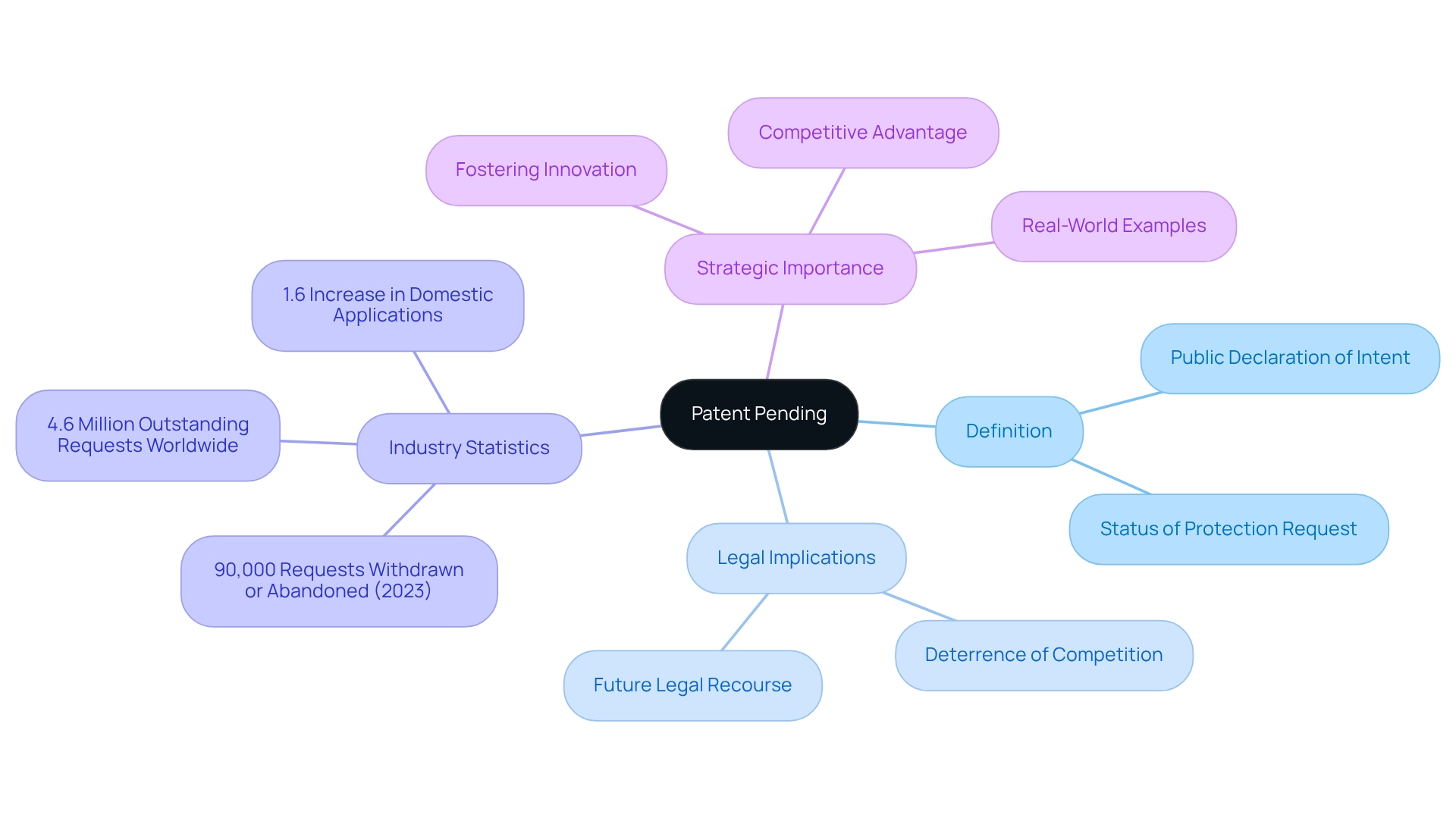
Contextualize ‘Patent Pending’: Importance in Intellectual Property Management
Patent awaiting’ designation raises the question of what does it mean patent pending, as it is a critical component of intellectual property administration, offering inventors temporary protection while their patent applications undergo examination. For startups, understanding what does it mean patent pending is particularly vital as it shows a proactive approach to safeguarding innovations and enhances their appeal to potential investors. Statistics indicate that startups with a robust intellectual property strategy, including what does it mean patent pending designation, are significantly more attractive to investors, as these rights are perceived as indicators of innovation and market viability.
Moreover, ‘patent in process’ serves as a deterrent against potential infringers, as it relates to what does it mean patent pending, signaling that the inventor is committed to their intellectual property rights. This status can bolster a company’s credibility in a competitive landscape, leading to questions about what does it mean patent pending, facilitating partnerships and securing funding.
As noted by Carson Patents, “They provide legal protection, prevent competitors from stealing ideas, attract investors, enhance market competitiveness, expand into new markets, and generate additional revenue streams.”
Utilizing iPNOTE’s AI-driven platform can further enhance the management of ‘patent awaiting’ conditions. Companies that leverage iPNOTE have reported substantial success, including a 7x return on investment in deal volume and a 2x growth in deals within just two months. This showcases how effective advertising strategies and tailored content can attract clients even in specialized markets. The Prime Ultra plan offers a comprehensive business solution that guarantees a 3x increase in customer acquisition through personalized marketing strategies, SEO and social media promotion, personal assistance, detailed analytics, exclusive partner advantages, and customized support, establishing it as an essential resource for startups navigating the complexities of IP oversight.
For instance, Oculus VR’s head-mounted VR display technology is protected by US Patent No. 10,754,602, underscoring the importance of ‘patent awaiting’ designation in safeguarding innovative technology. A study conducted by the European Patent Office (EPO) and the European Union Intellectual Property Office (EUIPO) reveals that startups with strong IP strategies—such as securing patents and trademarks—often ask what does it mean patent pending, as this knowledge not only protects their innovations but also enhances their prospects of obtaining funding and achieving successful exits.
Numerous examples exist of businesses that have effectively employed the ‘patent pending’ designation, raising the question of what does it mean patent pending to strengthen their market position. By showcasing their commitment to innovation, these companies have attracted significant investment, emphasizing what does it mean patent pending in the context of their business development strategies. In conclusion, knowing what does it mean patent pending is not merely a legal formality; it is a strategic asset that can profoundly influence funding success rates and overall market competitiveness for startups, especially when supported by a platform like iPNOTE.
Explore Characteristics of ‘Patent Pending’: Legal Framework and Operational Insights
The condition of ‘intellectual property under review’ is dictated by specific legal structures that differ across jurisdictions, indicating that a request has been submitted and is pending evaluation. During this period, inventors are unable to enforce their rights against potential infringers, as these rights are not granted until the patent is issued.
Nevertheless, the ‘patent pending’ designation can serve as a strategic marketing tool, signaling innovation and potential exclusivity to stakeholders and competitors alike, which raises the question of what does it mean patent pending. IP managers must remain vigilant in tracking the status of their submissions, as the duration of the ‘patent pending’ phase can vary significantly.
For instance, the typical delay from the submission of amendments to the subsequent Office Action can extend over several months, influenced by the office’s workload and the complexity of the filing.
Notably, approximately 75% of patent submissions encounter at least one office action, a standard aspect of the patent examination process, underscoring the regularity of this evaluation procedure.
In 2020, South Korea’s Patent Office recorded 226,759 patent requests, reflecting a robust commitment to technology and innovation among its businesses. This substantial volume of filings illustrates the proactive measures that businesses take to protect their intellectual assets and maintain a competitive edge in the global marketplace.
Understanding the legal frameworks governing ‘patent awaiting’ status is crucial for effective management. These frameworks can vary significantly across jurisdictions, affecting how IP managers navigate the complexities of unresolved submissions. For example, as of 2025, various jurisdictions continue to adapt their regulations.
Furthermore, the information provided by the USPTO is essential for grasping the processing times of intellectual property requests, which can aid IP managers in their strategic planning. By leveraging expert insights, who notes that searches conducted by intellectual property lawyers can take between one week and four weeks, along with operational strategies, companies can adeptly manage their applications pending approval, ensuring they optimize their potential for future intellectual property rights.
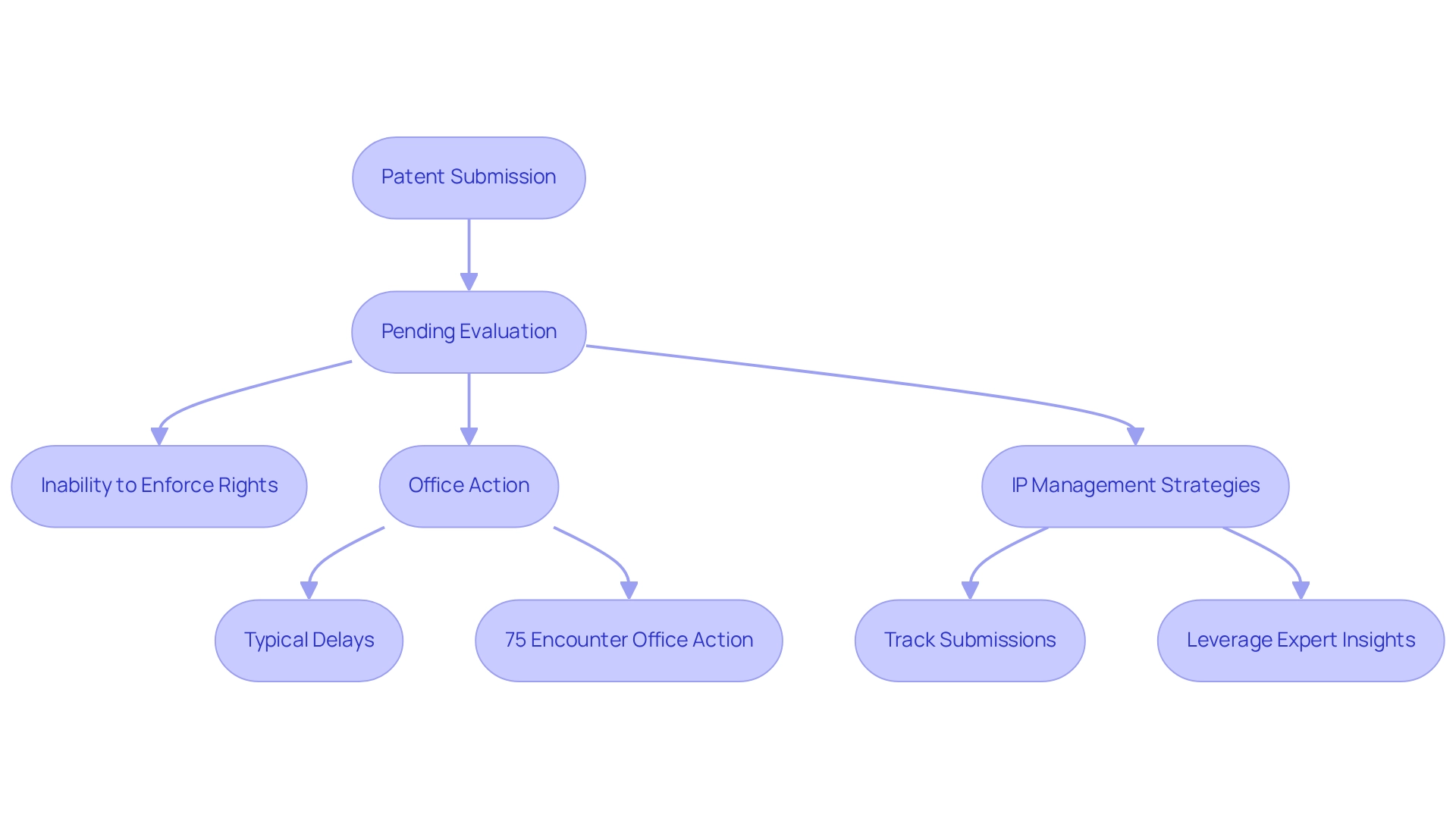
Evaluate Benefits and Drawbacks of ‘Patent Pending’: Strategic Considerations for IP Managers
Understanding what does it mean patent pending is important, as this status offers substantial benefits for inventors and IP managers. It serves as a deterrent against competitors, signaling what does it mean patent pending, and thereby discouraging imitation. Another critical advantage is the establishment of a priority date, which can be pivotal in disputes, affirming inventors’ claims to the originality of their creations. Furthermore, this status allows inventors to market their products as innovative, potentially attracting interest from investors and partners eager to support new technologies, which leads to the inquiry of what does it mean patent pending; however, significant drawbacks must also be considered. The ‘application in progress’ status does not confer enforceable rights, and until creators understand what does it mean patent pending, they cannot initiate legal action against infringers. The application process can be lengthy and expensive, with no assurance of a favorable outcome. Common reasons for refusals include lack of novelty, obviousness, and insufficient disclosure, complicating the path to securing a grant and highlighting what does it mean patent pending in terms of associated risks.
Granted inventions possess determinable asset valuation, whereas provisional submissions act merely as placeholders, highlighting the necessity of obtaining a grant to unlock the full value of an invention.
IP managers must carefully evaluate these factors when considering protection strategies. Engaging an intellectual property lawyer can be invaluable during this phase, as their expertise in preparing applications and navigating the examination process can significantly mitigate the risk of infringement and enhance the overall IP strategy. Case studies demonstrate that effective legal counsel can lead to stronger intellectual property protection and minimize potential challenges during the application phase. For example, patent attorneys are essential in advising on patent strategy and representing inventors during examinations, which can alleviate the disadvantages associated with understanding what does it mean patent pending status.
As the landscape evolves, patent holders must remain vigilant regarding market activities and potential infringements. Proactive measures, such as monitoring competitors and enforcing rights when necessary, are crucial for IP managers to safeguard their innovations effectively.
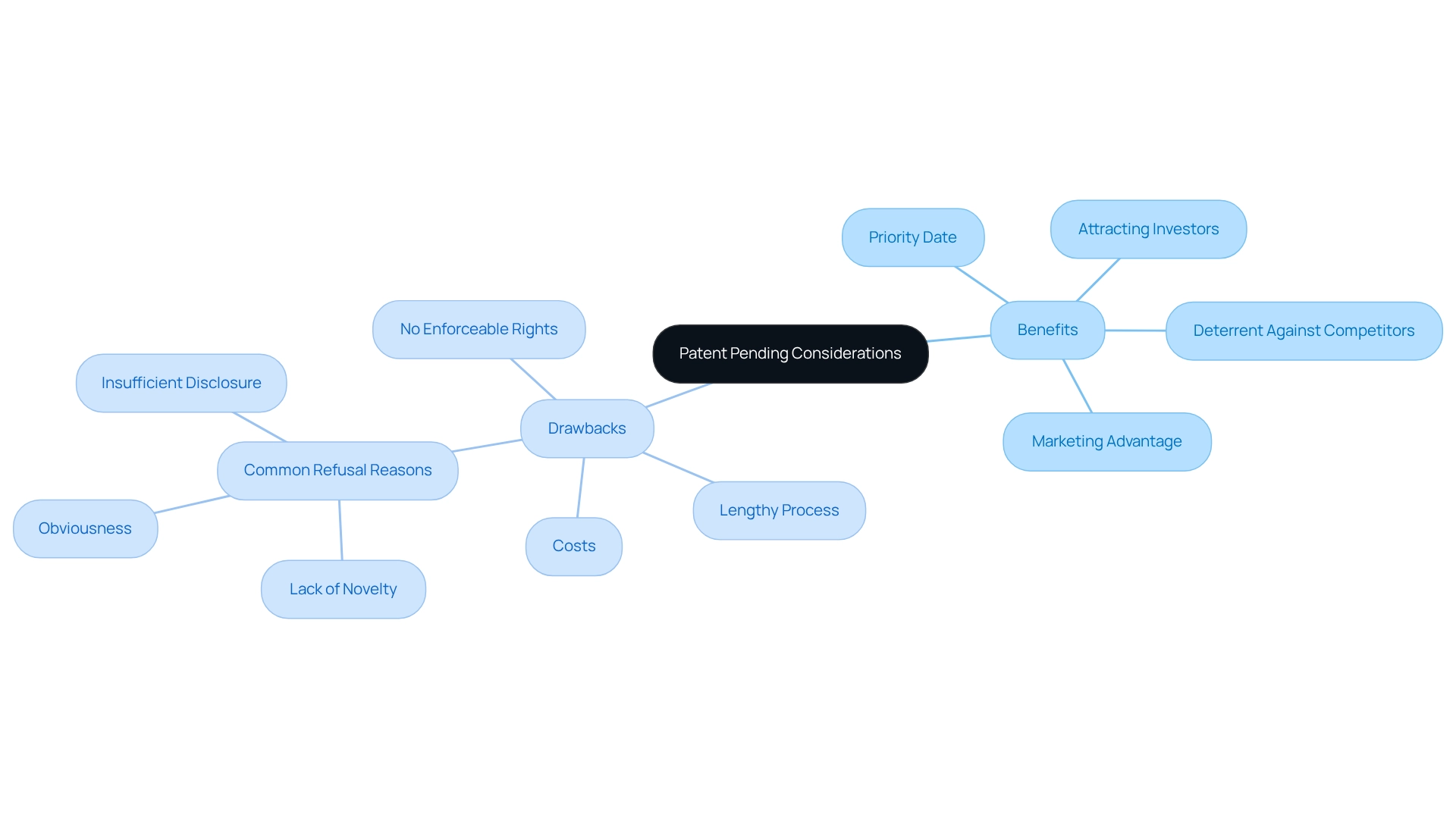
Conclusion
Understanding ‘patent pending’ is essential for innovators and businesses striving to protect their intellectual property effectively. This status not only indicates that a patent application is under review, but also acts as a deterrent against potential competitors, fostering an environment conducive to creativity. The implications of ‘patent pending’ extend well beyond mere legal formalities; they encompass strategic considerations that can significantly enhance market positioning and attract investment.
While ‘patent pending’ provides substantial advantages, such as establishing a priority date and enabling the marketing of innovations, it also presents challenges. The absence of enforceable rights until a patent is granted necessitates that inventors navigate a complex and often protracted application process. Engaging with seasoned patent attorneys and leveraging comprehensive IP management platforms can alleviate these challenges and increase the likelihood of successfully securing patents.
In an ever-evolving technological landscape, the importance of ‘patent pending’ cannot be overstated. By acknowledging its value, inventors and startups can strategically position themselves for growth, ensuring that their innovations are safeguarded while they pursue funding opportunities and market expansion. As competition intensifies, comprehending and utilizing ‘patent pending’ status becomes not merely advantageous but critical for sustainable innovation and business success.
Unlock the Power of ‘Patent Pending’ for Your Innovations! Start now with iPNOTE to simplify your IP management and secure your competitive edge.
Frequently Asked Questions
What does “patent pending” mean?
“Patent pending” refers to the status of a protection request that has been submitted to a patent office but has not yet received approval. It indicates that the inventor is actively pursuing legal protection for their invention.
What does the “patent pending” status signify for inventors?
The “patent pending” status signifies that the inventor has taken initial steps to secure exclusive rights for their invention, and that the request is currently under review.
Can inventors enforce their rights while their patent is pending?
No, enforceable rights against potential infringers do not materialize until the intellectual property is granted. However, the “patent pending” status can deter competitors from replicating the invention.
How does the “patent pending” designation affect competitors?
The designation alerts competitors that legal protections may soon be in place, suggesting the possibility of future legal recourse for the inventor upon approval of the patent.
What was the status of patent requests in the United States in 2023?
In 2023, approximately 90,000 patent requests were withdrawn or abandoned in the United States, highlighting the complexities inventors face in the intellectual property landscape.
How many intellectual property requests are outstanding worldwide?
The total number of outstanding intellectual property requests worldwide reached an estimated 4.6 million, with the U.S. holding the largest share.
What role does “patent pending” play in fostering innovation?
Understanding “patent pending” is vital for fostering innovation as it allows inventors to protect their concepts during the submission phase, enabling them to advance their products without the immediate threat of competition.
How can companies use the “patent pending” status strategically?
Companies leverage the “patent pending” designation to dissuade rivals and maintain a competitive advantage in their respective markets, illustrating its importance in strategic business planning.




